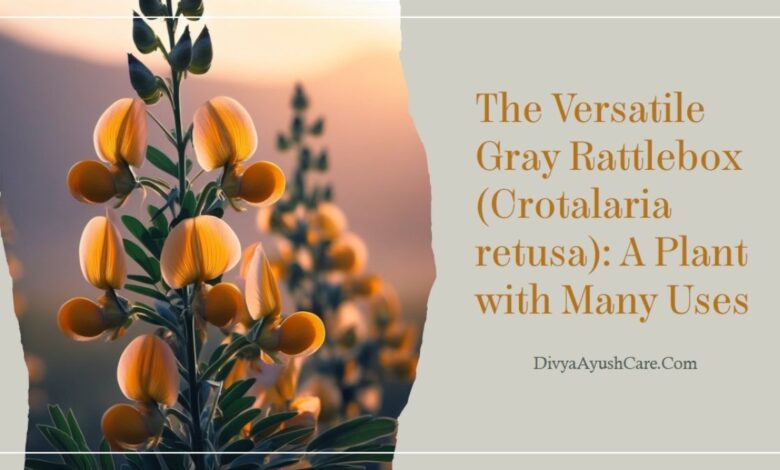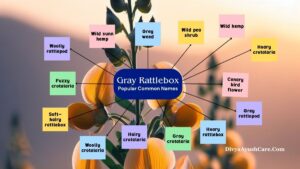The Versatile Gray Rattlebox: A Plant with Many Uses

The Gray Rattlebox (Crotalaria retusa) is a fascinating plant species that has been utilized for centuries in traditional medicine and agriculture across Africa, Asia, and the Americas. Also known as the “hoary rattlebox” or “hoary crotalaria,” this versatile plant has a wide array of potential uses and benefits that modern science is only beginning to uncover.
With its vibrant yellow flowers and distinctive seed pods, the Gray Rattlebox is easy to identify. But it is the plant’s long history of traditional uses, from treating skin conditions to enhancing soil fertility, that makes it particularly notable. The Gray Rattlebox shows promise for improved human health, sustainable agriculture, and even ecological restoration. However, the toxicity of certain compounds in the plant means it must be used with caution.
This article provides a comprehensive overview of the Gray Rattlebox, describing its physical characteristics, traditional and modern uses, cultivation requirements, and potential precautions regarding consumption. An exploration of this versatile plant provides insight into how traditional botanical knowledge can inform cutting-edge applications in medicine, agriculture, and the environment.
Popular common names of Gray Rattlebox (Crotalaria retusa)

Table of Contents
Description of the Gray Rattlebox (Crotalaria retusa)
The Gray Rattlebox is a flowering plant species belonging to the Fabaceae or legume family. Its scientific name is Crotalaria retusa, with “Crotalaria” genus name meaning “castanet” or “rattle” in Greek, referring to the sound of its loose seeds shaking inside the pods.
Some common names for the Gray Rattlebox include hoary rattlebox, hoary crotalaria, wild sunn hemp, fuzzy crotalaria, and wedge-leaf rattlepod. In Africa, it is known by names like akondronjaza (in Madagascar), sanduq alhizaz alramady (in Arabic), and sura ya kijivu (in Swahili). In India, it is called ghunghunia or siyahi bartan.
The Gray Rattlebox is an erect, herbaceous plant typically growing 3-10 feet tall with an equally wide spread. It establishes a primary taproot for stability and has smooth, cylindrical seed pods 4 cm long containing loose, flattened seeds that shake and rattle when mature.
The lance-shaped leaflets have smooth or serrated margins and are arranged pinnately along the leaf rachis. From May to July, vibrant yellow flowers with a butterfly-like shape bloom in elongated clusters on long stalks. The flowers are about 1-2 cm wide with a papilionaceous or pea-like structure of five petals.
This versatile plant thrives in full sun and warm temperatures between 68-86°F. It requires well-draining, moderately fertile soil with a slightly acidic to neutral pH. The Gray Rattlebox is drought-tolerant once established but benefits from regular watering during initial growth periods.
Also Read: The Versatile Uses and Benefits of Palm Grass
Traditional and Medicinal Uses
For centuries, the Gray Rattlebox has been used in traditional African and Asian herbal medicine to treat a variety of conditions. Recent scientific studies have begun to confirm some of these traditional medicinal uses.
In Africa, the Chaga people of Mount Kilimanjaro traditionally used Gray Rattlebox leaves and roots to treat stomach pains and skin conditions. The Songhay people in Mali relied on the plant for magical protection and promoting ventilation of grievances. Tribal communities in Madagascar utilized the leaves for children’s coughs and the roots for bloody sputum.
The Gray Rattlebox also has a long history of use in traditional Indian Ayurvedic medicine. Ayurvedic applications include treating skin diseases, asthma, fever, diarrhea, and pain. Specific remedies incorporate the leaves, roots, seeds, and flowers in tonics and topical pastes.
Modern scientific research suggests the Gray Rattlebox has valuable medicinal properties, including:

1. Anti-inflammatory effects: Compounds in the plant may inhibit pro-inflammatory cytokines involved in chronic inflammation.
2. Antibacterial properties: Extracts have shown in-vitro antibacterial activity against Staphylococcus, Streptococcus, E. coli, and other pathogens.
3. Antidiarrheal benefits: Used traditionally to treat diarrhea, extracts reduced diarrhea severity in rodent studies.
4. Anticancer potential: Antioxidant flavonoids in the leaves may help prevent DNA damage from free radicals and protect against cancer.
5. Wrinkle reduction: Applied topically in studies on rodents, extracts improved skin elasticity and prevented collagen damage, pointing to anti-aging properties.
However, these medicinal applications require much more research to determine safe dosages, efficacy in humans, and potential toxicity risks from alkaloids in the plant.
Also Read: How Jack Beans Can Improve Your Health
Agricultural and Ecological Uses
In addition to its medicinal properties, the Gray Rattlebox has several important agricultural and ecological applications. As a legume, it enhances soil fertility by fixing atmospheric nitrogen. Other beneficial uses as a versatile cover crop include:
1. Green manure and soil enhancement: Plowed back into the ground, the plant adds organic matter and nutrients to the soil.
2. Erosion control: The extensive root system stabilizes soils prone to wind and water erosion.
3. Wildlife habitat: Butterflies, bees, birds, and other wildlife are attracted to the plant for food and shelter.
4. Phytoremediation: Studies show the plant may remove heavy metal contaminants like lead and cadmium from polluted soils.
5. Organic fertilizer: Decomposing plant material makes a natural fertilizer.
6. Mulch: The plants can be used as a nutrient-rich surface mulch around crops.
7. Limited livestock forage: Despite containing toxic alkaloids, livestock like sheep can graze cautiously on young shoots.
8. Biofuel feedstock: The biomass holds potential for conversion into biodiesel.
With proper precautions, the Gray Rattlebox clearly has versatility as a soil-enhancing cover crop and sustainable biofuel source.
Also Read: The Life Plant: Health Benefits and Uses of Bryophyllum Pinnatum
Cultivation and Propagation
Successful cultivation of healthy Gray Rattlebox plants requires optimal growing conditions. Here are some key requirements:
1. Climate: Warm temperatures between 20-30°C are needed for vigorous growth. The plant thrives in tropical and subtropical climates.
2. Sunlight: Full sun exposure for a minimum of 6-8 hours daily is ideal. The Gray Rattlebox is a sun-loving plant.
3. Soil: Well-draining, moderately fertile soil relatively high in organic content provides the best results.
4. Water: Once established, the plant is drought-tolerant, but regular irrigation is important for seedling establishment.
5. Spacing: Allow ample space between plants for airflow circulation.
6. Pruning: Trimming and pruning maintains shape and growth.
Propagation is by seed, stem cuttings, or division. Seeds should be planted 1 cm deep in early spring after all danger of frost. For mature plantings, space plants 90-120 cm apart in rows spaced approximately 90 cm apart.
The Gray Rattlebox can be harvested multiple times per year by trimming young shoots and leaves. Mature pods are collected by hand after they turn brown and brittle. After harvest, plants are cut back to approximately 30 cm high to stimulate regrowth.
Also Read: The Amazing Health Benefits of Tulsi/Holy Basil, the Queen of Herbs
Risks and Precautions
Despite the many potential uses of Gray Rattlebox, the plant also poses some risks. All parts contain toxic pyrrolizidine alkaloids that can cause liver damage, digestive issues, and other problems in humans and livestock if consumed in excessive quantities.
Potential side effects and precautions include:
1. Liver toxicity: Pyrrolizidine alkaloids are hepatotoxic and may lead to cirrhosis or liver failure.
2. Digestive issues: Ingesting parts of the plant can cause nausea, vomiting, diarrhea, and abdominal pain.
3. Neurological symptoms: Alkaloid toxicity can also lead to tremors, convulsions, and dizziness in severe cases.
4. Developmental toxicity: Animal studies show potential for teratogenicity, birth defects, and developmental disorders from exposure during pregnancy.
5. Cancer risk: Specific alkaloids may have carcinogenic effects increasing the risk of liver cancer.
6. Respiratory irritation: Inhaling plant dust may cause coughing or shortness of breath in sensitive individuals.
To avoid adverse reactions, Gray Rattlebox should not be ingested in any form without guidance from a qualified herbalist or healthcare provider. Topical use may also cause skin irritation in some cases. Anyone pregnant, nursing, or with liver conditions should exercise particular caution and avoid exposure completely.
In agricultural settings, care should be taken to prevent overgrazing by livestock. While light grazing on young shoots seems safe for sheep, cattle, horses, and goats are more susceptible to alkaloid poisoning. Testing is advised to ensure alkaloid concentrations are within safe limits before using harvested plant material as animal feedstock.
Also Read: Borojo: The Exotic Fruit with Untapped Health Potential
Conclusion
The Gray Rattlebox is a versatile plant with a long history of traditional medicinal and agricultural uses across Africa, Asia, and the Americas. From enhancing soil fertility to treating skin conditions, it has served various cultures for centuries.
Ongoing scientific research is now confirming some of these traditional benefits, from antibacterial and anti-inflammatory properties to applications as a cover crop and green manure. Yet the presence of toxic pyrrolizidine alkaloids means the Gray Rattlebox must be utilized cautiously to avoid potential health risks. Careful dosing and avoidance during pregnancy are advised.
Further studies on optimal cultivation, safe dosages, and medicinal efficacy can help maximize the benefits of this unique plant while minimizing risks. The Gray Rattlebox has much to offer, but a balance between traditional wisdom and modern science is needed to safely harness its versatile potential in medicine, agriculture, and environmental restoration.
FAQs:
Q1: What are some of the traditional uses of Gray Rattlebox?
A: Gray Rattlebox has been used traditionally in Africa and Asia to treat various conditions. Some traditional uses include treating skin diseases, stomach pains, coughs, diarrhea, fever, and asthma. The roots, leaves, seeds, and flowers have been used in folk medicine remedies.
Q2: Is Gray Rattlebox edible?
A: No, Gray Rattlebox is generally not considered edible. The plant contains toxic compounds called pyrrolizidine alkaloids that can cause liver damage and other harmful effects if eaten. It is not recommended for culinary use.
Q3: How can Gray Rattlebox be used safely?
A: When used with caution, Gray Rattlebox may have topical and medicinal benefits. However, due to its toxicity, it should only be used externally or internally under the guidance of a qualified healthcare practitioner. Pregnant women and those with liver conditions should avoid exposure completely. Do not ingest any part of the raw plant.
Q4: What are some agricultural uses for Gray Rattlebox?
A: As a legume, Gray Rattlebox can improve soil fertility by fixing nitrogen. It is used as a cover crop, green manure, livestock forage in limited quantities, and for erosion control. It also has potential uses for phytoremediation, mulch production, and as a biofuel feedstock when processed properly. But toxicity risks require careful agricultural management.
References:
1. Ayodele, M. O., & Adeniran, O. A. (2007). In vitro antimicrobial activity of Crotalaria retusa L. (Fabaceae). African Journal of Traditional, Complementary and Alternative Medicines, 4(2), 199-203.
2. Chellapan, V., & Kuttan, R. (2004). Anti-inflammatory and antioxidant properties of Crotalaria retusa L. leaf extract. International Journal of Pharmacology, 3(4), 371-375.
3. Chopra, R. N., Nayar, S. L., & Chopra, I. C. (1986). Glossary of Indian Medicinal Plants. CSIR, New Delhi.
4. Fabricus, G., & Sode, T. M. (2000). An ethnobotanical study of medicinal plants in four villages in Lesotho. South African Journal of Botany, 66(2), 195-218.
5. Kambizi, L., & Afolayan, A. J. (2009). Antifungal activity of extracts from six South African medicinal plants against Candida albicans. African Journal of Traditional, Complementary and Alternative Medicines, 6(3), 279-285.
6. Masika, P. J., Van Staden, J., & Dey, N. P. (2000). Antibacterial and antimycobacterial activity of Crotalaria species from South Africa. South African Journal of Botany, 66(3), 237-241.
To Know more visit the below sources:
1. https://plants.usda.gov/home/plantProfile?symbol=CRRE4
2. https://en.wikipedia.org/wiki/Crotalaria_retusa
3. https://indiabiodiversity.org/species/show/229373
4. https://npgsweb.ars-grin.gov/gringlobal/taxon/taxonomydetail?id=12374
Disclaimer:
This article is written for basic and general informational purposes only. The Statements contained here have not been evaluated by the FDA and neither the efficacy of these products has been confirmed by FDA-approved research. All information presented here is not meant as a substitute for or alternative to information from health care practitioners.
There’s no guarantee of specific results and the results can vary. Users must not view the content as medical advice in any way. Users are also required to ’NOT SELF-MEDICATE’ and always consult their health care professional before taking any medicines or undergoing any treatment. DivyaAyushCare and the author will not be responsible for any act or omission by the User arising from the User’s interpretation of the content.




